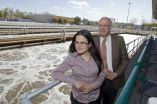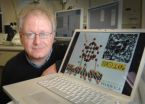(Press-News.org) Boulder, CO, USA - It's not hard to argue in favor of alternatives to fossil fuels these days, but one popular argument – domestic energy security – may be standing on very shaky legs. A lot of rare metals are needed to make photovoltaic panels, rare earth magnets for wind generators, fuel cells and high-capacity batteries for hybrid and electric vehicles. But most industrialized nations, including the United States, are almost entirely dependent on foreign sources for those metals. The only way this is going to change is if there is more domestic exploration and mining.
"There's a misunderstanding in the public about moving to alternative energy and moving from mining, which can't be done," said James Burnell of the Colorado Geological Survey. Burnell will be speaking about the resource demands of alternative energy technologies on 2 Nov. at the annual meeting of the Geological Society of America in Denver.
There is a long list of scarce metals needed for alternative energy and transportation. Metals like gallium, indium, selenium, tellurium, and high purity silicon are needed to make photovoltaic panels. To make batteries there's zinc, vanadium, lithium and rare earth elements as well as platinum group minerals for fuel cell-powered vehicles. One of the biggest players in the scarce metals game is China, and they are starting to play hard ball, says Burnell.
China is preparing to build 330 giga-watts worth of wind generators. That will require about 59,000 tons of neodymium to make high-strength magnets -- more than that country's annual output of neodymium. China supplies the world with a lot of those rare earth elements, like neodymium, and will have little or none to export if it moves ahead with its wind power plans.
"So the source for the West is problematical," said Burnell. Trade wars are on the horizon, he predicted. Yet policy makers and the public seem only superficially aware of the problem.
"It is obvious that Japan was upset by the practical pause of rare earth export by China in late September," said Yasushi Watanabe of the Institute for Geo-Resources and Environment in Tsukuba, Japan. On Nov. 1 at the same Geological Society of America meeting Watanabe will be presenting his work on the geology of these critical elements and where they can be found.
New sources of these critical metals are needed, said Watanabe, as well as new methods for extracting the rare elements from different kinds of rocks.
"Extraction methods of metals from new minerals and materials are not well established," said Watanabe. "We need to develop new (refining) and smelting methods for new type ores."
We also need to find those ores and start exploiting them, said Burnell. That means more mining. It's the only way we can stay competitive in the new energy future.
INFORMATION:
WHAT
Paper No. 132-1: Critical Metals for the New Energy Future
Abstract link: http://gsa.confex.com/gsa/2010AM/finalprogram/abstract_178652.htm
Session No. 132: Critical Metals (REE, In, Te, Nb, Ta, Ga, Li, etc.) for the New Energy Future
http://gsa.confex.com/gsa/2010AM/finalprogram/session_26175.htm
WHEN & WHERE:
1:30 PM-1:45 PM, Monday, 1 November 2010, Colorado Convention Center: Room 601
WHAT
Paper No. 205-3: Resource Demands of Alternative Energy Technologies
Abstract link: http://gsa.confex.com/gsa/2010AM/finalprogram/abstract_180221.htm
Session No. 205: Reaching New Peaks in Geoscience: Geoscience in the Service of a Sustainable Future
http://gsa.confex.com/gsa/2010AM/finalprogram/session_26203.htm
WHEN & WHERE
2:10 PM-2:30 PM, Tuesday, 2 November 2010
Colorado Convention Center: Room 107/109
For on-site assistance during the 2010 Annual Meeting, 31 October November, contact Christa Stratton in the Newsroom (7:30 a.m.-6:00 p.m. MDT), Colorado Convention Center, Room 206, +1-303-228-8429.
The Geological Society of America, founded in 1888, is a scientific society with more than 22,000 members from academia, government, and industry in more than 97 countries. Through its meetings, publications, and programs, GSA enhances the professional growth of its members and promotes the geosciences in the service of humankind. Headquartered in Boulder, Colorado, GSA encourages cooperative research among earth, life, planetary, and social scientists, fosters public dialogue on geoscience issues, and supports all levels of earth science education.
www.geosociety.org
Scarcity of new energy minerals will trigger trade wars
2010-11-02
ELSE PRESS RELEASES FROM THIS DATE:
UC research: Rabbit's food brings luck in decreasing estrogen levels in wastewater
2010-11-02
The November 2010 issue of "Environmental Pollution" details successful experiments at the University of Cincinnati wherein rabbit's food resulted in the abiotic (non-biological) transformation and absorption of four different types of estrogen, reducing the levels of these estrogen hormones by more than 80 percent in wastewater.
The research has practical implications since it could point to inexpensive treatment technologies and materials for reducing estrogens in wastewater.
Currently, estrogen in wastewater represents a major conduit for the entry of the hormone, ...
Antibiotics have long-term impacts on gut flora
2010-11-02
Short courses of antibiotics can leave normal gut bacteria harbouring antibiotic resistance genes for up to two years after treatment, say scientists writing in the latest issue of Microbiology, published on 3 November.
The researchers believe that this reservoir increases the chances of resistance genes being surrendered to pathogenic bacteria, aiding their survival and suggesting that the long-term effects of antibiotic therapy are more significant than previously thought.
Antibiotics that are prescribed to treat pathogenic bacteria also have an impact on the normal ...
Childhood stroke study identifies the contraceptive pill and smoking as risk factors
2010-11-02
Researchers are calling for clear guidelines on childhood stroke after a study, published in the November issue of Acta Paediatrica, found wide variations in time lag to diagnosis, investigation and treatment.
They are also keen to see the development of appropriate rehabilitation services, after a follow-up study found that 85% of the children who survived a stroke had neurological dysfunction or limitations.
Dr Sten Christerson studied the records of all children who had experienced their first stroke over a seven-year period in the Uppsala-Orebro Health Care Region, ...
Arthritis drugs could help prevent memory loss after surgery, study suggests
2010-11-02
Anti-inflammatory drugs currently used to treat diseases such as rheumatoid arthritis may also help prevent cognitive problems after surgery, according to a new study by researchers at Imperial College London and University of California, San Francisco (UCSF).
The research also reveals for the first time that a specific inflammatory response in the brain may explain why many patients experience memory loss or other forms of cognitive dysfunction after surgery or critical illness.
The findings, from research in mouse models, could lead to human clinical trials within ...
Quantum computing with braids in flatland
2010-11-02
When confined to a 2-dimensional sheet, some exotic particle-like structures known as anyons appear to entwine in ways that could lead to robust quantum computing schemes, according to research appearing in the November 1 issue of the journal Physical Review B. The physicists at Bell Laboratories who performed the research are hopeful the anyons can be induced to follow paths that twist into braids that would be much more resistant to disturbances that corrupt data and calculations in quantum computers relying on individual particles.
The anyons the researchers believe ...
Virginia Tech computer scientist, student design award winning software to combat hacking
2010-11-02
One of the serious threats to a user's computer is a software program that might cause unwanted keystroke sequences to occur in order to hack someone's identity. This form of an attack is increasing, infecting enterprise and personal computers, and caused by "organized malicious botnets," said Daphne Yao, assistant professor of computer science at Virginia Tech (http://www.cs.vt.edu/user/115).
To combat the "spoofing attacks," Yao and her former student, Deian Stefan, now a graduate student in the computer science department at Stanford University, developed an authentication ...
Typists' errors and intention theories
2010-11-02
New research published today in the journal Science says people think about things they think they don't think about. Vanderbilt University psychologists Gordon Logan and Matthew Crump say when highly skilled people such as surgeons, carpenters, or pilots perform actions without thinking, those actions are highly controlled. The finding adds key information to a debate on whether people consciously perform actions in which they are highly skilled.
Previous research suggests conscious control of driving a car for an experienced driver, for example, is an illusion. These ...
Race may influence uterine cancer recurrence, despite treatment
2010-11-02
DETROIT – African Americans are more likely to have a recurrence of uterine cancer despite undergoing a total hysterectomy or a hysterectomy followed by radiation therapy, according to researchers at Henry Ford Hospital in Detroit.
"The African American patients in our study had similar surgeries and radiation therapy as the Caucasian patients in the study. So access to care certainly wasn't a factor in race being identified as a negative predictor for outcome," says lead author Mohamed Elshaikh, M.D., senior staff physician in the Department of Radiation Oncology at ...
NPL builds long range alpha detector
2010-11-02
The UK's National Physical Laboratory (NPL) has developed a new portable radiation detector that can assess the safety of potentially contaminated areas far quicker than current methods. The prototype was inspired by the aftermath of the murder of Alexander Litvinenko in London 2006.
Litvinenko's death was due to radiation poisoning from polonium-210. It prompted wide-scale work to assess radiation levels at almost 50 premises in London that he had been prior to his death before opening them up again to the public, costing the Health Protection Agency £2 million.
The ...
Pivoting hooks of graphene's chemical cousin could revolutionize work of electron microscopes
2010-11-02
The single layer material Graphene was the subject of a Nobel prize this year but research led by a team of researchers at the University of Warwick has found molecular hooks on the surface of its close chemical cousin, Graphene Oxide, that will potentially provide massive benefits to researchers using transmission electron microscopes. They could even be used in building molecular scale mechanisms.
The research team, which includes Drs. Jeremy Sloan, Neil Wilson and PhD student Priyanka Pandey from the Department of Physics and Dr. Jon Rourke from the Department of Chemistry ...


